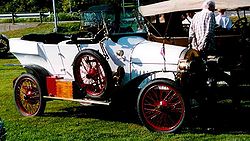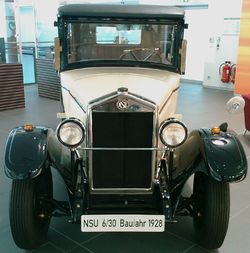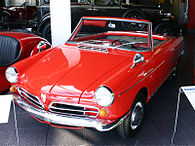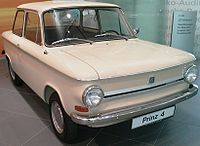- NSU Motorenwerke
-
NSU Motorenwerke AG, normally just NSU, was a German manufacturer of automobiles, motorcycles and pedal cycles, founded in 1873. It was acquired by Volkswagen Group in 1969. VW merged the company with Auto Union, to eventually evolve into Audi as it is known today.
Contents
History
NSU began as a knitting machine manufacturer in the town of Riedlingen on the Danube in 1873, and moved to Neckarsulm, where the river Sulm flows into the Neckar, in 1884. In 1886 the company began to produce bicycles, the first of them branded as the "Germania", and by 1892, bicycle manufacturing had completely replaced knitting machine production. At about this time, the name NSU (from Neckar and Sulm) appeared as a brand name.
The first NSU motorcycle appeared in 1901,[1] followed by the first NSU car in 1905. In 1932, the car factory in Heilbronn was sold to Fiat.
During World War II NSU designed and produced the Kettenkrad, the NSU HK101, a half-tracked motorcycle with the engine of the Opel Olympia.
In December 1946 Das Auto reported the company had resumed the manufacture of bicycles and motor-bicycles at Neckarsulm.[2] For Germany this was a time of new beginnings: in July 1946, a new board had been appointed, headed up by General Director Walter Egon Niegtsch, who earlier in his career had spent 17 years with Opel.[2]
NSU motorbike production restarted, in a completely destroyed plant, with pre-war designs like the Quick, OSL and Konsul motorbikes; furthermore, the HK101 continued to be sold by NSU as an all-terrain vehicle in a civilian version. The first post-war model was the NSU Fox in 1949, available in a 2-stroke and a 4-stroke version. In 1953 the NSU Max followed, a 250 cc motorbike with a unique overhead camdrive with connecting rods. All these new models had an innovative monocoque frame of pressed steel and a central rear suspension unit. Albert Roder, the chief engineer behind the success story, made it possible that in 1955 NSU became the biggest motorcycle producer in the world. NSU also holds 4 world records for speed: 1951, 1953, 1954, and 1955. In August 1956 Wilhelm Herz at the Bonneville Salt Flats, Utah, became the first man to ride a motorcycle faster than 200 mph (322 km/h).
In 1957 NSU re-entered the car market with the new Prinz (Prince), a small car with a doubled NSU Max engine, an air-cooled two-cylinder engine of 600 cc (37 cu in) and 20 hp (15 kW). Motorbike production continued until 1968. NSU's last production motorcycle was the Quick 50.[3][4]
In 1964 NSU offered the world's first Wankel engined car: the Wankelspider. In development of the project, NSU built the Sport Prinz, with a 129 hp (96 kW) 995 cc (60.7 cu in) 2-rotor.[5] In the same year Prinz 1000 and derivatives like the TT and TT/S followed. The Typ 110 (later called 1200SC) was launched in 1965 as a family car with a more spacious body design. The last NSU cars with a conventional four-stroke engine had the air-cooled OHC four-cylinder engine in common.
In 1967, the four-door NSU Ro 80, with a 115 hp (86 kW) version of the same 2-rotor,[6] was presented to public. Weighing 2,600 lb (1,200 kg), it had a Cd of 0.36, disc brakes, independent suspension, and front wheel drive by Fichtel & Sachs Saxomatic three-speed transmission.[6] It soon gained several design awards such as "car of the year 1967", while drivers liked its performance.[6] Virtually all the world's major motor manufacturers purchased licenses from NSU to develop and produce the rotary engine, with the notable exception of BMW.[7]
Despite its public acclaim, sales of the Ro 80 were disappointing. The transmission drew complaints and the engine suffered numerous failures even at low mileage.[6] Competitor automakers, apart from Mazda, held back from taking a lead in developing and marketing the Wankel technology, and anticipated income associated with those royalty deals failed to materialize.
Volkswagen Group takeover
The development of the rotary engine was very cost-intensive for the small company. Problems with the tip seals of the engine rotor significantly damaged the brand's reputation amongst consumers. In 1969, the company was taken over by Volkswagen Group, who merged NSU with Auto Union. The new, merged, company was called Audi NSU Auto-Union A.G and represented the effective end of both the NSU and DKW marques with all future production to bear the Audi badge (although retaining the four interlocking circles of Auto Union). The management of the Neckarsulm plant moved to Audi's headquarters in Ingolstadt. When the small rear-engined NSU models (Prinz 4, 1000, 1200) were phased out in 1973, the Ro 80 was the last car still in production carrying the NSU badge. Audi never made use of the brand name NSU again after April 1977, when the last Ro 80 was sold.[6]
Even as production of the Ro 80 continued in the Neckarsulm plant, production of larger Audi models like 100 and 200 was started. The Porsche 924 and later Porsche 944 were also assembled at Neckarsulm. Those models were joint venture projects of Porsche and VW, but Porsche did not have the internal capacity to build the 924 and 944. Currently, Neckarsulm is the production plant for Audi's topline vehicles like A6, A8 and R8. It is also the home of the "Aluminium- und Leichtbauzentrum" where Audi's aluminium-made space frame bodies are designed and engineered.
NSU is primarily remembered today as the first licensee and one of only three automobile companies to produce cars for sale with rotary Wankel engines. NSU invented the principle of the modern Wankel engine with an inner rotor. The NSU Ro 80 was the second mass-produced two-rotor Wankel-powered vehicle after the Mazda Cosmo. In 1967, NSU and Citroën set up a common company, Comotor, to build engines for Citroën and other car makers. Only Mazda continued developing the Wankel engine. Mazda currently has a sportscar, the RX-8, in its portfolio using the Wankel engine family.
A museum in Neckarsulm, the Deutsches Zweirad- und NSU-Museum, has many of NSU's products on display.
Lawn mower engine
In the early 1970s, NSU manufactured a vertical-crankshaft small engine for use as a lawn mower power unit.[8]
NSU cars
NSU produced the following post - war cars:
- NSU Prinz I, II, 30 and III (1957–1962)
- NSU Sport Prinz (1959–1967)
- NSU Prinz 4, 4L (1961–1972)
- NSU Prinz 1000, NSU 1000 (1964–1972)
- NSU 1000 TT, NSU TT, NSU TTS (1965–1972)
- NSU Typ 110, NSU 1200 (1965–1972)
- NSU Spider (1964–1967)
- NSU Ro 80 (1967–1977)
- NSU K70, produced after VW/Audi takeover as the Volkswagen K70 (1970–1975)
NSU motorcycles
-
Sidecar (Germany, 2002)
NSU had several successes in the Isle of Man TT races in the 1950s. NSU holds 4 World records for speed: 1951, 1953, 1954 and 1955. During the 1930s, and in the mid 1950s NSU was the largest motorcycle producer of the world.
The NSU Quickly was the most popular moped of its time.[citation needed] It was produced between 1953 and 1966 in over 1,000,000 examples and still can be found today all over the world as more than 60% were exported.
NSU bicycles
Bicycle production began in 1900 and continued into the early 1960s.[9]
Military vehicles
- NSU Kettenkrad halftracked motorcycle (1940–1949)
See also
- List of German companies
- List of German cars
- Auto Union
References
- ^ Ric Anderson (Premier Issue). "1956 NSU Supermax". Motorcycle Classics. http://www.motorcycleclassics.com/motorcycle-reviews/1956-nsu-supermax.aspx. Retrieved 2009-8-24.
- ^ a b "Aktuelles aus aller Welt". Auto Motor u. Sport Heft 13 1996: Seite 23. date December 1946.
- ^ "NSU Quickly Spares Gallery". Nsuquicklyspares.co.uk. http://www.nsuquicklyspares.co.uk/gallery.html. Retrieved 2010-10-02.
- ^ "Fredy's NSU Page:Quick 50". Nsu-cars.ch. http://www.nsu-cars.ch/Quick50.htm. Retrieved 2010-10-02.
- ^ Lyons, Pete. "10 Best Ahead-of-Their-Time Machines", in Car and Driver, 1/88, p.78.
- ^ a b c d e Lyons, p.78.
- ^ "In voller Blüte. In den sechziger Jahren...". Auto Motor u. Sport Heft 13 1996: Seite 76–83. date 14 June 1996.
- ^ "Now You Can 'Mow' with a Wankel!" Popular Science, July 1973 p. 18
- ^ "1951 NSU Ladies Tourenrad Model 55". Online Vintage Bicycle Museum. http://oldbike.wordpress.com/1951-nsu-damenrad/. Retrieved 2011-06-05.
External links
- de:Deutsches Zweirad- und NSU-Museum [1]
- NSU Prinz in German & English
- Restored NSU Sport Prinz in Israel
Major and Notable German motorcycle marques Volkswagen Group Divisions and
subsidiariesAudi AG (quattro GmbH) · Bentley Motors Ltd · Bugatti Automobiles S.A.S. · Lamborghini S.p.A. · SEAT, S.A. · Škoda Auto · Volkswagen Passenger CarsVolkswagen Commercial Vehicles · Scania AB (publ) (71.8%)GeographicVolkswagen Group of America, Inc. (Electronics Research Laboratory) · Volkswagen do Brasil · Volkswagen Group China · Volkswagen Group in India · Volkswagen Group IrelandShareholdings Porsche AG (49.9%) · MAN SE (55.9%) · IAV GmbH (50%) · Suzuki Motor Corporation (19.9%) · Italdesign Giugiaro S.p.ADefunct marques Executives
(former and current)Maj. Ivan Hirst (REME) (former Managing Director) → Heinrich Nordhoff (former Managing Director) → Kurt Lotz (former CEO) → Rudolf Leiding (former CEO) → Toni Schmücker (former CEO) → Carl Hahn (Chairman Emeritus) → Ferdinand Piëch (Chairman of the Supervisory Board) → Bernd Pischetsrieder (former CEO) → Martin Winterkorn (current Chairman of the Board of Management)Products and
technologiesEnginesTechnologiesPlaces Categories:- Motorcycle manufacturers of Germany
- Defunct motor vehicle manufacturers of Germany
- Scooter manufacturers
- Moped manufacturers
- Audi
- Volkswagen Group
- NSU Motorenwerke
- NSU motorcycles
- Car manufacturers of Germany
- Companies disestablished in 1977
- Companies established in 1873
Wikimedia Foundation. 2010.
















